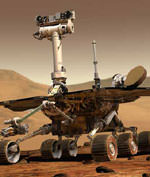
Image credit: NASA/JPL
NASA’s Spirit rover made a slight correction to its trajectory on December 26, when it fired its thrusters for 3.4 seconds. The maneuver went flawlessly, and put the lander right on course to land in Mars’ Gusev Crater on January 4 at 0435 UTC (11:35 pm EST January 3). This was Spirit’s fourth trajectory correction maneuver since its launch on June 10, and two more might still happen in the final days if its flight is a little off-target. As with Beagle 2, the most dangerous part of the mission will happen when the rovers have to pass through Mars atmosphere and land safely on the planet.
NASA’s Spirit rover spacecraft fired its thrusters for 3.4 seconds on Friday, Dec. 26, to make a slight and possibly final correction in its flight path about one week before landing on Mars.
Radio tracking of the spacecraft during the 24 hours after the maneuver showed it to be right on course for its landing inside Mars’ Gusev Crater at 04:35 Jan. 4, 2004, Universal Time (8:35 p.m. Jan. 3, Pacific Standard Time.) Spirit’s twin, Opportunity, will reach Mars three weeks later.
“The maneuver went flawlessly,” said Dr. Mark Adler, Spirit mission manager at NASA’s Jet Propulsion Laboratory, Pasadena, Calif.
This was Spirit’s fourth trajectory correction maneuver since launch on June 10. Two more are on the schedule for the flight’s final three days, if needed. Adler said, “It seems unlikely we’ll have to do a fifth trajectory correction maneuver, but we’ll make the final call Thursday morning after we have a few more days of tracking data. Right now, it looks as though we hit the bull’s-eye.”
The adjustment was a quick nudge approximately perpendicular to the spacecraft’s spin axis, said JPL’s Chris Potts, deputy navigation team chief for the NASA Mars Exploration Rover project. “It moved the arrival time later by 2 seconds and moved the landing point on the surface northeast by about 54 kilometers” (33 miles), Potts said. The engine firing changed the velocity of the spacecraft by only 25 millimeters per second (about one-twentieth of one mile per hour).
For both NASA rovers approaching Mars, the most daunting challenges will be descending through Mars’ atmosphere, landing on the surface, and opening up properly from the enclosed and folded configuration in which the rovers arrive. Most previous Mars landing attempts, by various nations, have failed.
Each rover, if it arrives successfully, will then spend more than a week in a careful sequence of steps before rolling off its lander platform. The rovers’ mission is to examine their landing areas for geological evidence about past environmental conditions. In particular, they will seek evidence about the local history of liquid water, which is key information for assessing whether the sites ever could have been hospitable to life. Opportunity will land halfway around Mars from Spirit.
As of 13:00 Universal Time (6 a.m. PST) on New Year’s Day, Spirit will have traveled 481.9 million kilometers (299.4 million miles) since launch and have will have 5.1 million kilometers (3.2 million miles) left to go. Opportunity will have traveled 411 million kilometers (255 million miles) since its July 7 launch and will have 45 million kilometers (27.9 million miles) to go, with three remaining scheduled opportunities for trajectory correction maneuvers.
JPL, a division of the California Institute of Technology, manages the Mars Exploration Rover project for NASA’s Office of Space Science, Washington.
Additional information about the project is available from JPL at http://marsrovers.jpl.nasa.gov and from Cornell University, Ithaca, N.Y., at http://athena.cornell.edu.
Original Source: NASA/JPL News Release
